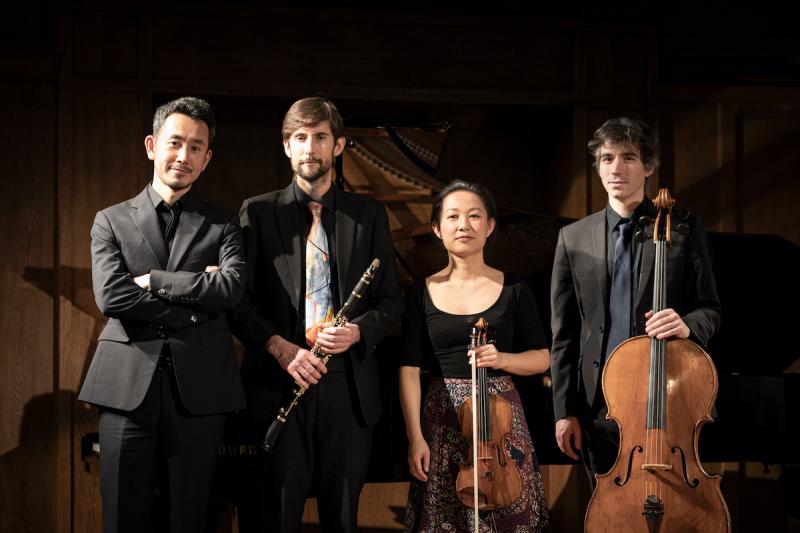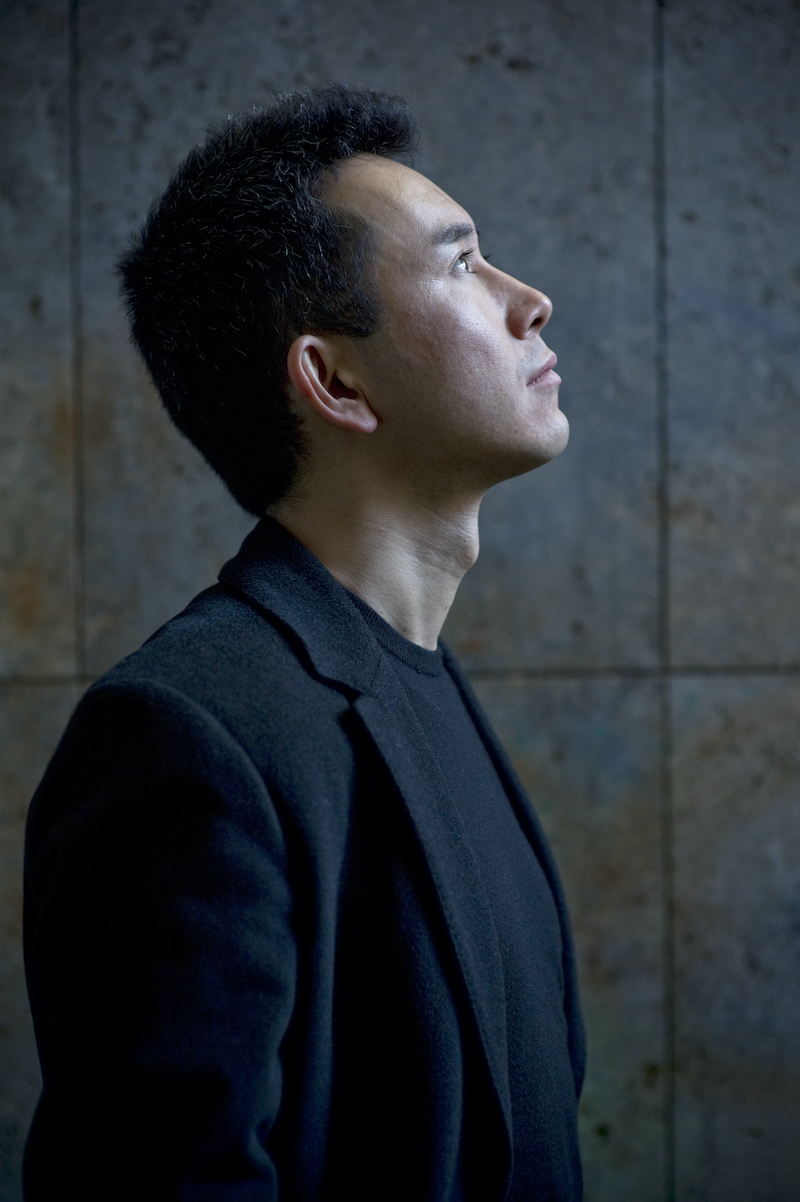Oriole Ensemble, Conway Hall review - sublimely peculiar chamber music | reviews, news & interviews
Oriole Ensemble, Conway Hall review - sublimely peculiar chamber music
Oriole Ensemble, Conway Hall review - sublimely peculiar chamber music
Interesting juxtaposition throws a light on 20th century repertoire

When I reviewed the Philharmonia’s Weimar season last year I expressed a hope to hear more Hindemith performed in London. When, also last year, I reviewed chamber music at Conway Hall I looked forward to my next visit. So a Conway Hall programme including Hindemith’s Clarinet Quartet was like a magnet.
Conway Hall is an enterprising venue, as much community centre as concert hall, with a long tradition of Sunday evening chamber music. The attendance was impressive, especially for a programme of fairly challenging 20th century repertoire. The ensemble is a new group called the Oriole Ensemble, a group of old friends and colleagues centred around pianist Hiro Takenouchi (pictured below by Jean-Baptiste Millot). They played with the easy assurance and comfortable familiarity of an established group and were very well-received.
The fact that Hindemith and Messiaen both chose the same scoring for their pieces is fortuitous. Hindemith wrote his quartet in 1938, apparently not to commission, and the composition of the Messiaen, in an internment camp during World War II, was entirely determined by the players who happened to be there. For pieces written so near in time they are remarkably different, Hindemith’s clearly in the European chamber music tradition, although with lots of nods to Baroque textures, while the Messiaen is a unique conception, utterly eccentric in lots of respects, a fact that can be forgotten through its familiarity.
 The Hindemith is a very democratic chamber music, all the instruments equal in status, whether in contrapuntal textures, or when taking turns with the primary melody. The Oriole Ensemble were sensitive to balance at all times, especially when the piano dropped out: the beginning of the second movement was wonderfully together in its sense of stillness. Pianist Hiro Takenouchi was equally at home in Brahmsian ripples or in the clangorous chords of the stormy middle section, which lifted him off his feet. The finale has sections of American expansiveness (Hindemith was to move to the US shortly after) and – in its startling coda – Bartókian wildness leading to an unresolved ending.
The Hindemith is a very democratic chamber music, all the instruments equal in status, whether in contrapuntal textures, or when taking turns with the primary melody. The Oriole Ensemble were sensitive to balance at all times, especially when the piano dropped out: the beginning of the second movement was wonderfully together in its sense of stillness. Pianist Hiro Takenouchi was equally at home in Brahmsian ripples or in the clangorous chords of the stormy middle section, which lifted him off his feet. The finale has sections of American expansiveness (Hindemith was to move to the US shortly after) and – in its startling coda – Bartókian wildness leading to an unresolved ending.
If the Hindemith Quartet has its peculiarities, Messiaen’s Quartet for the End of Time is completely strange, an unlikely masterpiece, no doubt helped in its popularity by the extraordinary story of its composition and first performance, on decrepit instruments to an outdoor audience of prisoners and guards in Stalag VIII-A in January 1941. Compositionally it draws together all Messiaen’s techniques of the time: harmony derived from his modes, melody from his study of birdsong, and rhythm through an Indian primer he had come across. It is as sternly Catholic as anything he wrote, but with a religious ecstasy that often borders on kitsch.
As an eight-movement chamber piece it is also odd. Only four of the movements feature all four instruments, and one of those has them all playing in unison throughout. This is the sixth movement, the “Dance of Fury”, and furious it was, fast and exciting, an unforgiving texture for the players (there were occasional tiny slips of ensemble). The first movement, “Liturgy of Crystal” is my favourite, the piano playing an eternally looping series of chords against birdsong melodies in the other instruments, serene, undeveloping, unvarying, magical.
But the real heart of the piece is in the three solo movements, for clarinet alone, and violin and cello respectively with piano. The clarinet movement, “Abyss of Birds” is extraordinary theatre, the other players sitting and listening for 10 minutes of mostly hushed solo music. Clarinettist William Stafford controlled both the theatre and music beautifully, long notes emerging from nothing, glistening with overtones.
The fifth movement puts a long-breathed melody over repeating, occasionally shifting, piano chords. Takenouchi shaped these intelligently, letting the ebb and flow pick out the way the chords always threaten to resolve but never do. Cellist Christian Elliott soared appropriately, but also found moments of fragility. The music is maximalist, wearing its heart on its sleeve, but its sentimentality at times threatens to overwhelm, maybe just remaining tethered to good taste by Messiaen’s sincerity.
The final movement is companion to the fifth, offering another view of the eternal, this time the violin (Sijie Chen) takes her turn to soar, the piano chords now unevenly spaced and Takenouchi bringing out individual notes, finding inner lines from within the chords, and finding resonances from the body of the piano. The music eventually floats off the top of the instruments as if a bird set free, an affecting image to end a piece written in captivity, and a monument to its composer’s faith.
rating
Explore topics
Share this article
The future of Arts Journalism
You can stop theartsdesk.com closing!
We urgently need financing to survive. Our fundraising drive has thus far raised £49,000 but we need to reach £100,000 or we will be forced to close. Please contribute here: https://gofund.me/c3f6033d
And if you can forward this information to anyone who might assist, we’d be grateful.

Subscribe to theartsdesk.com
Thank you for continuing to read our work on theartsdesk.com. For unlimited access to every article in its entirety, including our archive of more than 15,000 pieces, we're asking for £5 per month or £40 per year. We feel it's a very good deal, and hope you do too.
To take a subscription now simply click here.
And if you're looking for that extra gift for a friend or family member, why not treat them to a theartsdesk.com gift subscription?
more Classical music
 Solomon, OAE, Butt, QEH review - daft Biblical whitewashing with great choruses
Even a top soprano and mezzo can’t make this Handel paean wholly convincing
Solomon, OAE, Butt, QEH review - daft Biblical whitewashing with great choruses
Even a top soprano and mezzo can’t make this Handel paean wholly convincing
 Two-Piano Gala, Kings Place review - shining constellations
London Piano Festival curators and illustrious friends entertain and enlighten
Two-Piano Gala, Kings Place review - shining constellations
London Piano Festival curators and illustrious friends entertain and enlighten
 Echo Vocal Ensemble, Latto, Union Chapel review - eclectic choral programme garlanded with dance
Beautiful singing at the heart of an imaginative and stylistically varied concert
Echo Vocal Ensemble, Latto, Union Chapel review - eclectic choral programme garlanded with dance
Beautiful singing at the heart of an imaginative and stylistically varied concert
 Scott, Irish Baroque Orchestra, Whelan, RIAM, Dublin review - towards a Mozart masterpiece
Characteristic joy and enlightenment from this team, but a valveless horn brings problems
Scott, Irish Baroque Orchestra, Whelan, RIAM, Dublin review - towards a Mozart masterpiece
Characteristic joy and enlightenment from this team, but a valveless horn brings problems
 Classical CDs: Voice flutes, flugelhorns and froth
Baroque sonatas, English orchestral music and an emotionally-charged vocal recital
Classical CDs: Voice flutes, flugelhorns and froth
Baroque sonatas, English orchestral music and an emotionally-charged vocal recital
 Kanneh-Mason, Britten Sinfonia, Shave, Milton Court - a grin and a big beaming smile
A pair of striking contemporary pieces alongside two old favourites
Kanneh-Mason, Britten Sinfonia, Shave, Milton Court - a grin and a big beaming smile
A pair of striking contemporary pieces alongside two old favourites
 theartsdesk at the New Ross Piano Festival - Finghin Collins’ musical rainbow
From revelatory Bach played with astounding maturity by a 22 year old to four-hand jazz
theartsdesk at the New Ross Piano Festival - Finghin Collins’ musical rainbow
From revelatory Bach played with astounding maturity by a 22 year old to four-hand jazz
 First Person: Manchester Camerata's Head of Artistic Planning Clara Marshall Cawley on questioning the status quo
Five days of free events with all sorts of audiences around Manchester starts tomorrow
First Person: Manchester Camerata's Head of Artistic Planning Clara Marshall Cawley on questioning the status quo
Five days of free events with all sorts of audiences around Manchester starts tomorrow
 Goldscheider, Brother Tree Sound, Kings Place review - music of hope from a young composer
Unusual combination of horn, strings and electronics makes for some intriguing listening
Goldscheider, Brother Tree Sound, Kings Place review - music of hope from a young composer
Unusual combination of horn, strings and electronics makes for some intriguing listening
 theartsdesk Q&A: composer Donghoon Shin on his new concerto for pianist Seong-Jin Cho
Classical music makes its debut at London's K-Music Festival
theartsdesk Q&A: composer Donghoon Shin on his new concerto for pianist Seong-Jin Cho
Classical music makes its debut at London's K-Music Festival

Add comment